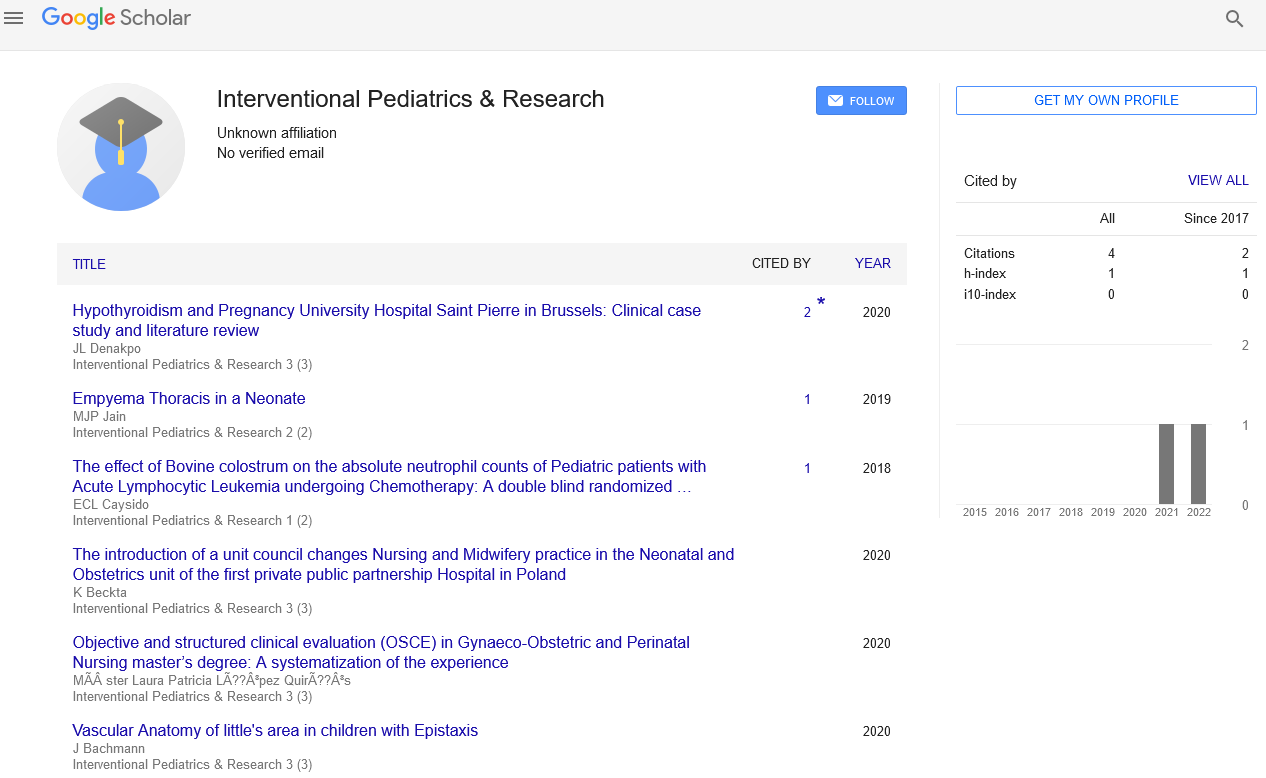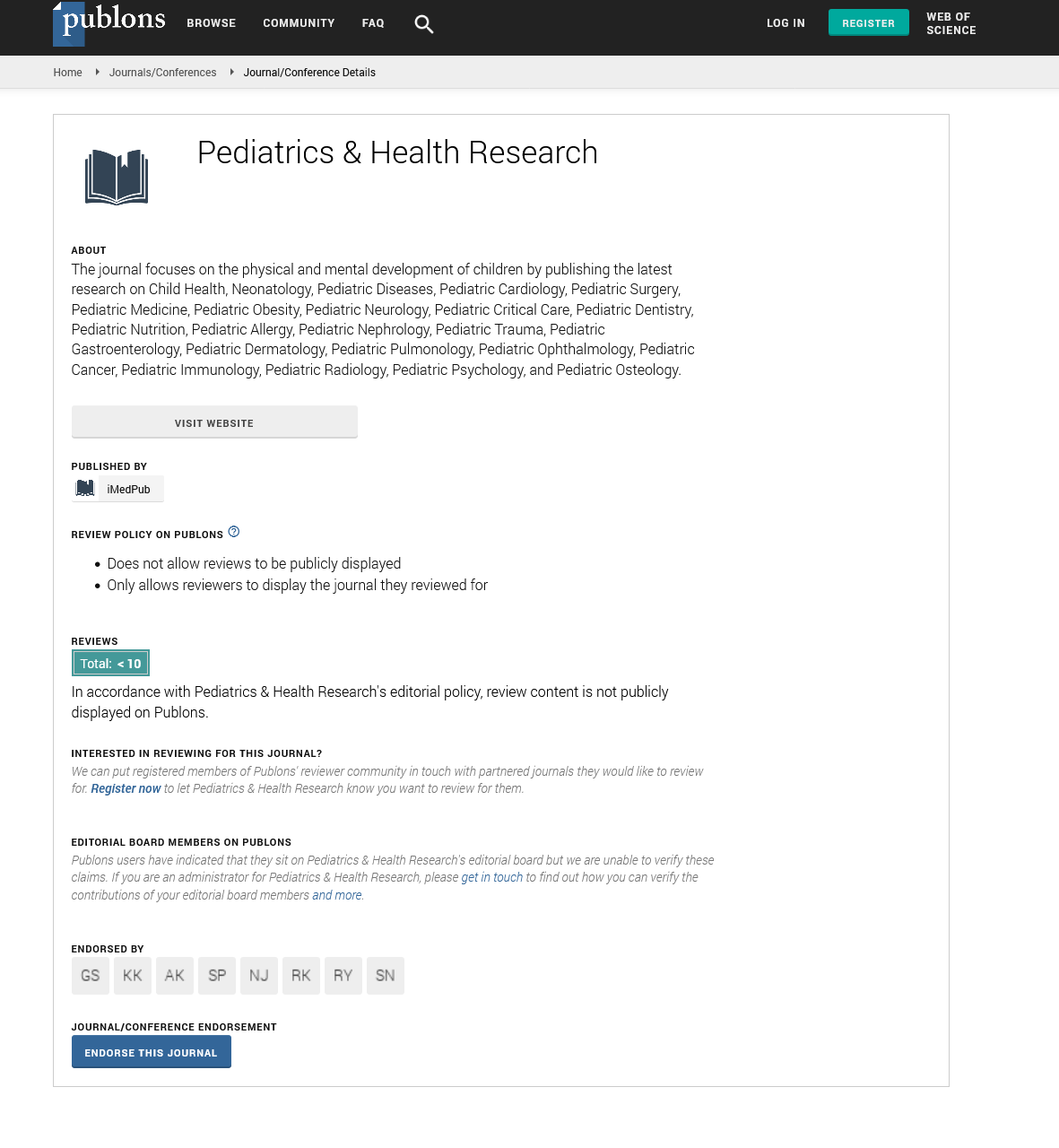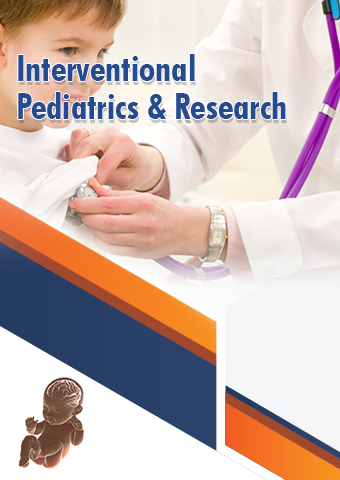Editorial - Interventional Pediatrics & Research (2023) Volume 6, Issue 4
Pediatric Interventional Pulmonology: Advancements in Respiratory Care for Children
Guoxiang Cheng*
Department of Pediatric, King Abdulaziz University, Saudi Arabia
Department of Pediatric, King Abdulaziz University, Saudi Arabia
E-mail: Guoxiang56@gmail.com
Received: 01-Aug -2023, Manuscript No. ipdr-23- 110724; Editor assigned: 03-Aug-2023, Pre-QC No. ipdr-23- 104424 (PQ); Reviewed: 19-Aug- 2023, QC No. ipdr -23- 104424; Revised: 23-Aug-2023, Manuscript No. ipdr-23- 104424 (R); Published: 30-Aug-2023, DOI: 10.37532/ ipdr.2023.6(4).80-82
Abstract
Pediatric interventional pulmonology is an emerging medical field dedicated to diagnosing and treating respiratory disorders in children through minimally invasive procedures. These procedures involve advanced imaging techniques and specialized tools, offering less invasive alternatives to traditional surgical interventions. This article aims to provide an overview of pediatric interventional pulmonology, highlighting its scope, benefits, challenges, and future directions.A comprehensive review of the literature was conducted to gather information on various interventional pulmonology procedures performed in children, including bronchoscopy, lung biopsies, bronchial thermoplasty, and tracheostomy management. Advantages of minimally invasive interventions, such as reduced pain, faster recovery, and precise diagnosis, were examined. Challenges faced by the field, such as specialized training and research requirements, were also discussed. Pediatric interventional pulmonology encompasses procedures addressing congenital and acquired respiratory disorders. These interventions, guided by advanced imaging, lead to shorter hospital stays, quicker recovery times, and improved patient outcomes. Challenges in training and the need
Keywords
Pediatric interventional pulmonology • Respiratory disorders • Traditional surgical interventions • Lung biopsies • Bronchial thermoplasty
Introduction
Pediatric interventional pulmonology is a rapidly evolving medical field dedicated to the diagnosis and treatment of various respiratory disorders in children through minimally invasive procedures. These procedures often involve advanced imaging guidance and specialized tools, allowing medical professionals to manage a wide range of conditions affecting the airways, lungs, and surrounding structures. The field’s growth has brought about transformative changes in the management of pediatric respiratory disorders, offering less invasive alternatives to traditional surgical interventions [1]. The field of pediatric interventional pulmonology has revolutionized the management of respiratory disorders in children. Through minimally invasive approaches, specialized care is provided, enhancing the quality of life for young patients. Collaboration among healthcare specialists will drive advancements in technology, imaging, and therapies, ensuring brighter prospects for pediatric respiratory health in the future [2].
Description
Pediatric interventional pulmonology is a specialized medical discipline that focuses on diagnosing and treating a wide range of respiratory conditions affecting children using minimally invasive procedures. Unlike traditional open surgeries, interventional pulmonology utilizes advanced imaging techniques and specialized instruments to perform precise interventions on the airways, lungs, and associated structures. The advantages of pediatric interventional pulmonology include shorter hospital stays, reduced pain, quicker recovery times, and minimal scarring. It allows for personalized treatment plans tailored to each child’s unique condition, enhancing the overall quality of life for pediatric patients and their families.As the field continues to evolve, ongoing research and collaboration between pediatric pulmonologists, interventional radiologists, and other medical specialists will drive the development of innovative techniques, improved imaging modalities, and novel therapies. Pediatric interventional pulmonology holds the promise of shaping a brighter future for children with respiratory disorders, offering them effective and minimally invasive solutions to regain their respiratory health.
Scope of pediatric interventional pulmonology
Pediatric interventional pulmonology encompasses a diverse array of procedures tailored to the unique needs of children [3]. This field addresses both congenital and acquired respiratory disorders, including but not limited to
Bronchoscopy and airway interventions: Pediatric interventional pulmonologists use bronchoscopy to visualize and treat conditions such as airway stenosis, tracheomalacia, and foreign body removal. They may also employ techniques like balloon dilation or stent placement to widen narrowed airways and ensure unobstructed breathing [4].
Lung biopsies and drainage: When diagnosing lung diseases like interstitial lung disease or infections, interventional pulmonologists can perform minimally invasive lung biopsies. They can also place drainage catheters to manage pleural effusions or abscesses [5].
Bronchial thermoplasty: This innovative procedure involves delivering controlled thermal energy to the airways, reducing the excessive smooth muscle present in conditions like severe asthma. Bronchial thermoplasty aims to improve asthma control and decrease the frequency of exacerbations [6].
Vascular anomalies: Pediatric interventional pulmonology plays a role in managing vascular anomalies involving the airways and lungs, such as haemoptysis (coughing up blood). Techniques like embolization can help control abnormal blood vessel growth [7].
Tracheostomy care and management: Children who require long-term tracheostomy tubes need specialized care to ensure optimal functioning and reduce complications. Pediatric interventional pulmonologists may perform tube changes, manage complications, and provide guidance to families.
Benefits of minimally invasive interventions
The advent of pediatric interventional pulmonology has significantly improved patient outcomes and quality of life. Some key advantages include,
Less invasive: Minimally invasive procedures result in smaller incisions or no incisions at all, reducing pain, scarring, and the risk of complications compared to traditional open surgeries [8].
Faster recovery: Children undergoing interventional pulmonology procedures often experience shorter hospital stays and quicker recovery times, enabling them to return to their normal activities sooner.
Precise diagnosis: Advanced imaging technologies, such as fluoroscopy and computed tomography (CT), aid in accurate diagnosis and treatment planning.
Personalized care: Pediatric interventional pulmonology allows for tailored treatment plans based on each child’s unique condition, ensuring the best possible outcomes [9].
Challenges and future directions
Despite its many benefits, pediatric interventional pulmonology faces certain challenges. Ensuring specialized training for healthcare professionals, particularly in pediatric populations, is essential. Additionally, continued research is required to refine existing procedures, develop new techniques, and gather long-term outcome data [10].
As the field evolves, exciting future directions include advancements in technology, enhanced imaging modalities, and novel therapies. Collaboration between pediatric pulmonologists, interventional radiologists, and other specialists will drive these advancements, ultimately leading to improved respiratory care for children.
Conclusion
Pediatric interventional pulmonology represents a groundbreaking approach to diagnosing and treating respiratory disorders in children. Through minimally invasive techniques, advanced imaging, and specialized tools, healthcare professionals can offer tailored, effective, and compassionate care to young patients. As the field continues to expand, it holds the promise of revolutionizing the management of pediatric respiratory conditions, providing brighter prospects for children’s respiratory health.
References
- Newby LK, Jesse RL, Babb JD et al. ACCF 2012 expert consensus document on practical clinical considerations in the interpretation of troponin elevations: a report of the American College of Cardiology Foundation task force on Clinical Expert Consensus Documents.J Am Coll Cardiol.60(23), 2427-2463(2012).
- Hagger R, Constantinou J, Shrotria S. Acute appendicitis after a fall from a ladder: a traumatic aetiology?.Emerg Med J.19(4), 366-367(2002).
- Spear R,Mack LA,Benedetti TJ et al.Idiopathic infantile arterial calcification.In uterodiagnosis.J Ultrasound Med.9(8),473–476(1990).
- Carles D,Serville F,Dubecq JP et al.Idiopathic arterial calcification in a stillborn complicated by pleural hemorrhage and hydrops fetalis.Arch Pathol Lab Med.116(3),293–295(1992).
- Miceli G, Rizzo G, Basso MG et al. Artificial Intelligence in Symptomatic Carotid Plaque Detection: A Narrative Review.Appl Sci.13(7), 4321(2023).
- Joanna N, Julia E, Alves F et al. Optical imaging in vivo with a focus on paediatric disease: technical progress, current preclinical and clinical applications and future perspectives.Pediatric radiology.41,161-175(2011).
- Denise BK, Marjorie J, Arca BD et al. Pediatric vascular injuries: patterns of injury, morbidity, and mortality.J Pediatr Surg. 42(1), 178-183(2007).
- Garey CL, Laituri CA, Valusek PA et al. Management of anterior mediastinal masses in children.Eur J Pediatr Surg. 21(5), 310-313(2011).
- Elluru RG, Balakrishnan K, Padua HM. Lymphatic malformations: diagnosis and management. InSeminars in pediatric surgery23(4), 178-185(2014).
- Alexander A, Richmond L, Geary D et al. Outcomes of percutaneous transluminal angioplasty for pediatric renovascular hypertension. J Pediatr Surg. 52(3), 395-9(2017).
Indexed at, Google Scholar, Crossref
Indexed at, Google Scholar, Crossref
Indexed at, Google Scholar, Crossref
Indexed at, Google Scholar, Crossref
Indexed at, Google Scholar, Crossref
Indexed at, Google Scholar, Crossref
Indexed at, Google Scholar, Crossref
Indexed at, Google Scholar, Crossref


